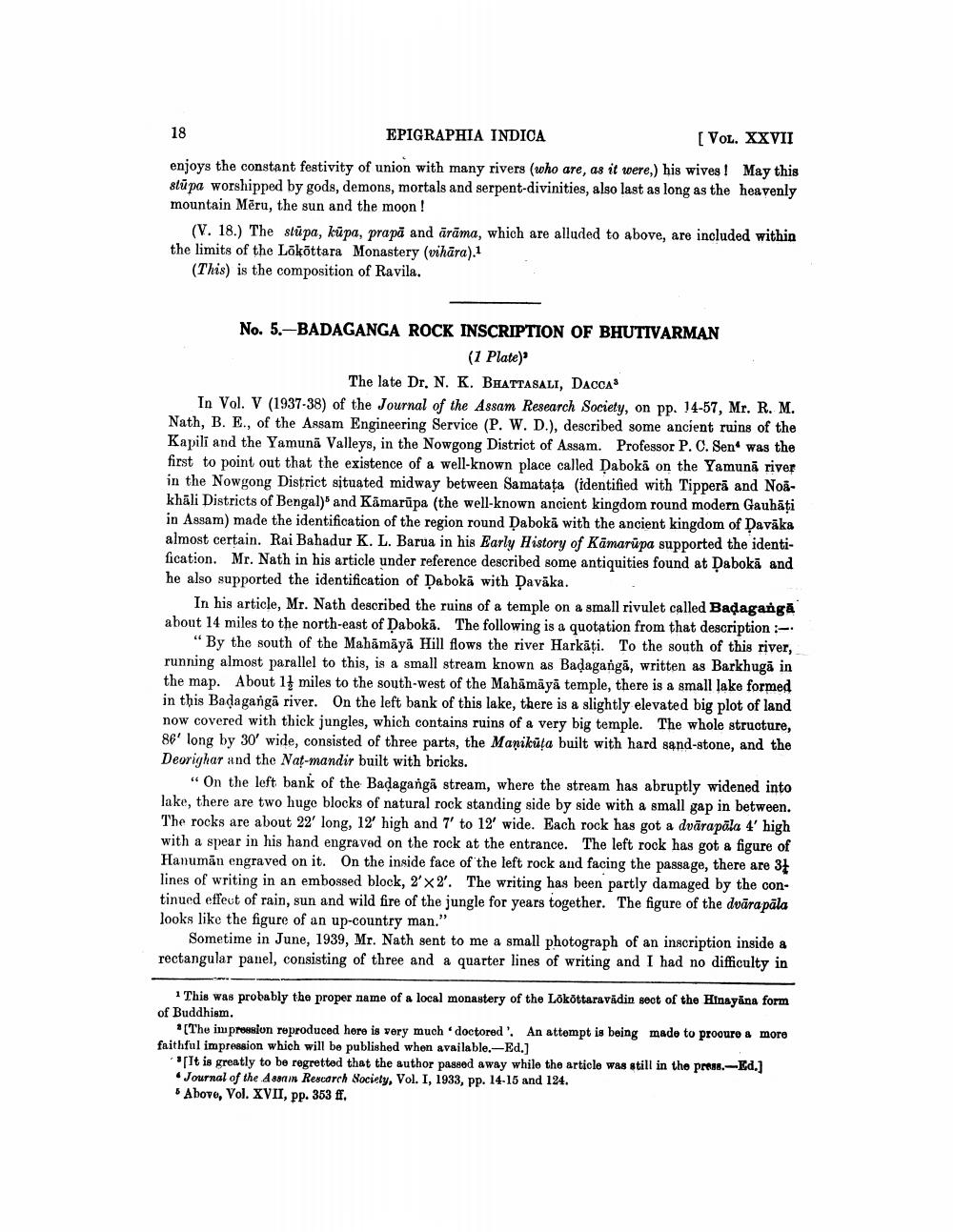________________
EPIGRAPHIA INDICA
[VOL. XXVII enjoys the constant festivity of union with many rivers (who are, as it were, his wives! May this stūpa worshipped by gods, demons, mortals and serpent-divinities, also last as long as the heavenly mountain Mēru, the sun and the moon!
(V. 18.) The stūpa, kūpa, prapă and ārāma, which are alluded to above, are included within the limits of the Lõkõttara Monastery (vihāra).1
(This) is the composition of Ravila,
No. 5.-BADAGANGA ROCK INSCRIPTION OF BHUTIVARMAN
(1 Plate)
The late Dr. N. K. BHATTASALI, DACCA In Vol. V (1937-38) of the Journal of the Assam Research Society, on pp. 14-57, Mr. R. M. Nath, B. E., of the Assam Engineering Service (P. W. D.), described some ancient ruins of the Kapili and the Yamunā Valleys, in the Nowgong District of Assam. Professor P. C. Sent was the first to point out that the existence of a well-known place called Dabokā on the Yamunā river in the Nowgong District situated midway between Samatata (identified with Tipperā and Noakhāli Districts of Bengal)" and Kämarūpa (the well-known ancient kingdom round modern Gauhāti in Assam) made the identification of the region round Dabokā with the ancient kingdom of Davāka almost certain. Rai Bahadur K. L. Barua in his Early History of Kamarüpa supported the identification. Mr. Nath in his article under reference described some antiquities found at Dabokā and he also supported the identification of Dabokā with Davāka.
In his article, Mr. Nath described the ruins of a temple on a small rivulet called Badagangā about 14 miles to the north-east of Dabokā. The following is a quotation from that description :-.
"By the south of the Mahāmāyā Hill flows the river Harkāti. To the south of this river, running almost parallel to this, is a small stream known as Badaganga, written as Barkhugā in the map. About 11 miles to the south-west of the Mahamaya temple, there is a small lake formed in this Badagangā river. On the left bank of this lake, there is a slightly elevated big plot of land now covered with thick jungles, which contains ruins of a very big temple. The whole structure, 86' long by 30' wide, consisted of three parts, the Manikūļa built with hard sand-stone, and the Deorighar and the Nat-mandir built with bricks.
“On the left bank of the Badagangă stream, where the stream has abruptly widened into lake, there are two huge blocks of natural rock standing side by side with a small gap in between. The rocks are about 22' long, 12' high and 7' to 12' wide. Each rock has got a dvārapāla 4' high with a spear in his hand engraved on the rock at the entrance. The left rock has got a figure of Hanuman engraved on it. On the inside face of the left rock and facing the passage, there are 34 lines of writing in an embossed block, 2'X2'. The writing has been partly damaged by the continued effect of rain, sun and wild fire of the jungle for years together. The figure of the dvāra pāla looks like the figure of an up-country man."
Sometime in June, 1939, Mr. Nath sent to me a small photograph of an inscription inside a rectangular panel, consisting of three and a quarter lines of writing and I had no difficulty in
1 This was probably the proper name of a local monastery of the Lökottaravädin sect of the Hinayana form of Buddhism.
* [The impression reproduced here is very much doctored'. An attempt is being made to proouro a more faithful impression which will be published when available.-Ed.)
It is greatly to be regretted that the author passed away while the article was still in the press.-Ed.] Journal of the Assain Rescarch Society, Vol. I, 1933, pp. 14-15 and 124. 5 Above, Vol. XVII, pp. 353 ff.




